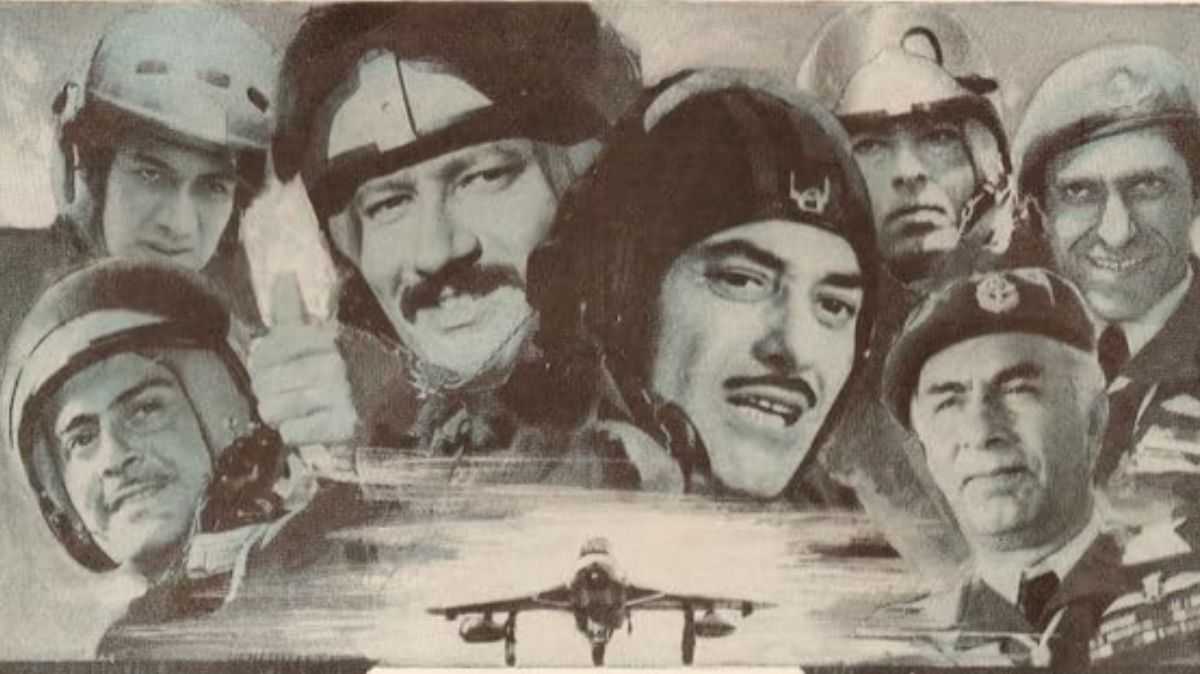Hindustan Ki Kasam is a 1973 Indian war film directed by Chetan Anand, focusing on Operation Cactus Lilly during the 1971 Indo-Pakistani War. Unlike Chetan Anand’s earlier successful war film Haqeeqat (1964), this one didn’t do well at the box office. In the realm of war cinema, the maestro filmmaker’s earlier masterpiece, “Haqeeqat,” etched an indelible mark, encapsulating the 1962 Sino-Indian conflict with cinematic finesse. Regarded by pundits as the pinnacle of war storytelling, it seamlessly blended a poignant narrative, heroics, picturesque locales, heart-wrenching lyrics, immortal compositions, deft editing, and stellar performances. A magnum opus that resonated beyond the screen and raked in box office glory.
Fast forward to the director’s sophomore venture into the war genre, where the canvas shifted from the grounded terrains of the 1962 war to the aerial battleground of the 1971 Indo-Pak conflict. However, the soaring ambitions met with mixed results. The emotional nuances, albeit present, found themselves overshadowed by mind-boggling aerial spectacles. The narrative’s crescendo, involving a Squadron Leader rescuing his beloved in a hand-to-hand combat scenario, felt forced, succumbing to external pressures and resulting in a lackluster climax. Unfortunately, the magic woven by Kaifi Azmi’s lyrics and Madan Mohan’s soulful compositions failed to cast the same spell.
A Brief Description of the Plot
The movie stands out in Indian cinema for its detailed portrayal of the Indian Air Force’s role in the 1971 war, specifically in the western sector. It begins with a Pakistan Air Force raid on an Indian Air Force airbase, where a pilot (Raaj Kumar) solemnly pledges to avenge the attack in the name of Hindustan.
The plot centers around the IAF’s mission to destroy a PAF radar that interferes with IAF pilots’ radios during combat. Indian intelligence employs Mohini, who resembles Tahira (played by Priya Rajvansh), the fiancée of a PAF pilot (Amjad Khan). Mohini goes to Pakistan, works as a singer on Pakistan TV, and discovers the location of the radar jammer. She informs the IAF, and a plan is set in motion.
The climax involves a dramatic air raid on the studio where the radar is housed. In the ensuing dogfight, Raaj Kumar’s jet is destroyed, but with IAF support, they successfully rescue the pilot and Tahira. The movie concludes with the IAF’s flyby during the Republic Day parade in New Delhi, accompanied by the title song.
Flight Through the Skies: A Cinematic Triumph Despite Pitfalls
The director’s leading lady, Priya Rajvansh, showcased her versatility in a double role, with her rendition of “Hai Tere saath mein nahin to kya,” accompanied by intercuts of warplanes. Balraj Sahni, hardly visible, added a subdued layer to the ensemble. The inclusion of Vijay Anand, Amjad Khan, Amrish Puri, Parikshat Sahni, Padma Khanna, and the director himself seemed promising but ultimately left much to be desired.
Noteworthy is the participation of actual fighter pilots, Flight Lieutenants Samar Shah and Manvir Singh, and others, adding an authentic touch to the aerial choreography supervised by Wing Commander Gautam, a Mahavir Chakra awardee for his wartime prowess.
What elevated the narrative to breathtaking heights were the airborne sequences, featuring sorties through iconic aircraft like Sukhoi, Sabers, Mig 21, Gnats, and Hunters. These aerial ballets, depicting Operation Cactus Lilly in the western sector during the 1971 conflict, intertwined seamlessly with the army’s engagement in the eastern sector. The filmmaker’s collaboration with actual footage, featuring the likes of Flight Lieutenants Samar Shah and Manvir Singh, added a layer of realism that resonated with the audience.
The narrative opened with a poetic flourish, setting the stage for a gripping tale. The credits rolled, culminating in a party at an air force mess, introducing a diverse cast of actors. Yet, editor Jadhav Rao found little room for romantic or emotional tracks amidst the engaging warfare. Jal Mistry’s cinematography soared, but art director Sudendhu Roy’s lapses, notably in the picturisation supposedly inside a Pakistani Television Studio, were apparent.
In the symphony of forgotten gems, Lata Mangeshkar’s rendition of “Hai tere saath meri wafa” shone bright, while Manna Dey’s “Har taraf ab yehi afsane hai” on Raaj Kumar lingered in the shadows of neglect. “Duniya banana wale yehi hai meri ilteja,” another Lata number, echoed silently in the annals of forgotten melodies.
Produced by Ravi Anand and directorially assisted by Mukul Anand, this cinematic odyssey stands as a tribute to the unsung heroes of the Indian Air Force, despite its flaws, encapsulating the triumphs and tragedies that unfold in the vast expanse of the skies.
You may find the full movie on YouTube.












